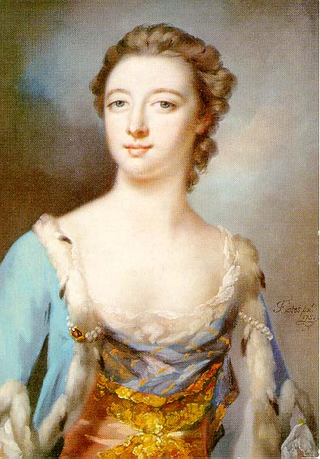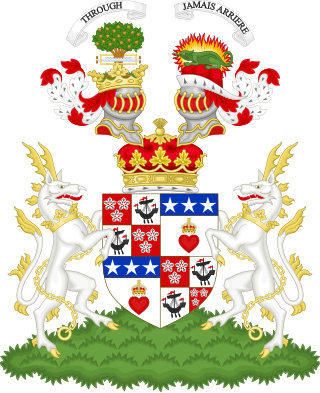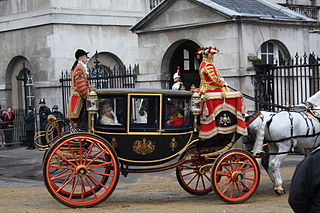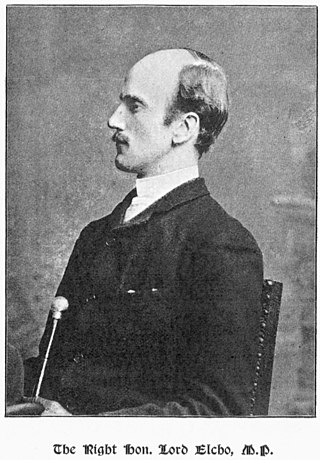This is a list of life peerages created prior to the Appellate Jurisdiction Act 1876 and the Life Peerages Act 1958.
This is a list of life peerages created prior to the Appellate Jurisdiction Act 1876 and the Life Peerages Act 1958.
A courtesy title is a form of address and/or reference in systems of nobility used for children, former wives and other close relatives of a peer, as well as certain officials such as some judges and members of the Scottish gentry. These styles are used "by courtesy" in the sense that persons referred to by these titles do not in law hold the substantive title. There are several different kinds of courtesy titles in the British peerage system.

Elizabeth Campbell, Duchess of Argyll, 1st Baroness Hamilton of Hameldon, earlier Elizabeth Hamilton, Duchess of Hamilton, née Gunning, was a celebrated Anglo-Irish beauty, lady-in-waiting to Queen Charlotte, and society hostess.

Duke of Hamilton is a title in the Peerage of Scotland, created in April 1643. It is the senior dukedom in that peerage, and as such its holder is the premier peer of Scotland, as well as being head of both the House of Hamilton and the House of Douglas. The title, the town of Hamilton in Lanarkshire, and many places around the world are named after members of the Hamilton family. The ducal family's surname, originally "Hamilton", is now "Douglas-Hamilton". Since 1711, the dukedom has been held together with the Dukedom of Brandon in the Peerage of Great Britain, and the dukes since that time have been styled Duke of Hamilton and Brandon, along with several other subsidiary titles.
The Peerage of Great Britain comprises all extant peerages created in the Kingdom of Great Britain between the Acts of Union 1707 and the Acts of Union 1800. It replaced the Peerage of England and the Peerage of Scotland, but was itself replaced by the Peerage of the United Kingdom in 1801.

Duchess of Kent is the principal courtesy title used by the wife of the Duke of Kent. There have been four titles referring to Kent since the 18th century. The current duchess is Katharine, the wife of Prince Edward. He inherited the dukedom on 25 August 1942 upon the death of his father, Prince George, the fourth son of George V.

Ehrengard Melusine von der Schulenburg, suo jureDuchess of Kendal, suo jureDuchess of Munster was a longtime mistress to King George I of Great Britain.
The titles of Earl of Kendal and Duke of Kendal have been created several times, generally for people with a connection to the English/British royal family. The title refers to Kendal, a town in Cumbria.

Baron Greenwich was a title in the Peerage of the United Kingdom that has been created twice in British history.
Earl of Feversham is a title that has been created three times, once in the Peerage of England, once in the Peerage of Great Britain and once in the Peerage of the United Kingdom. All three creations are now extinct.

Lady of the Bedchamber is the title of a lady-in-waiting holding the official position of personal attendant on a British queen regnant or queen consort. The position is traditionally held by the wife of a peer. A lady of the bedchamber would give instructions to the women of the bedchamber on what their queen wished them to do, or may carry out those duties herself.

Clan Douglas is an ancient clan or noble house from the Scottish Lowlands.

Elizabeth Stanhope, Countess of Chesterfield was an Irish-born beauty. She was a courtier after the Restoration at the court of Charles II of England at Whitehall. She was the second wife of Philip Stanhope, 2nd Earl of Chesterfield.
Baron Glastonbury is a title that was created twice in the Peerage of Great Britain. The first creation came on 19 March 1719, as a life peerage and as a subsidiary title for Ehrengard Melusine von der Schulenburg, Duchess of Kendal and Munster, mistress of George I.
Suo jure is a Latin phrase, used in English to mean 'in his own right' or 'in her own right'. In most nobility-related contexts, it means 'in her own right', since in those situations the phrase is normally used of women; in practice, especially in England, a man rarely derives any style or title from his wife although this is seen in other countries when a woman is the last heir of her line. It can be used for a male when such male was initially a 'co-lord' with his father or other family member and upon the death of such family member became the sole ruler or holder of the title "in his own right" (alone).
Elizabeth Boyle, Countess of Guildford, was an English peeress. She was created 1st Countess of Guildford for life at the Restoration on 14 July 1660, which became extinct upon her death c. 3 September 1667. She held the office of Groom of the Stole and Lady of the Bedchamber to the queen dowager, Henrietta Maria.

Hugo Richard Charteris, 11th Earl of Wemyss and 7th Earl of March DL, styled Lord Elcho from 1883 to 1914, was a British Conservative politician.

Frances Howard, Countess of Surrey was the second daughter and third child of John de Vere, 15th Earl of Oxford, and Elizabeth Trussell. She first married Henry Howard, Earl of Surrey, and second Thomas Steyning.
Frances Laura Spencer-Churchill, Duchess of Marlborough, was a British noblewoman and socialite. She was variously Viscountess Long, Countess of Dudley and became Duchess of Marlborough upon her fourth marriage, to John Spencer-Churchill, 10th Duke of Marlborough. She was the sister of novelist Hugo Charteris and Ann Charteris, as well as the granddaughter of Hugo Charteris, 11th Earl of Wemyss. Her third husband, Michael Temple Canfield, was the former husband of Lee Radziwill, sister of First Lady Jacqueline Bouvier Kennedy Onassis. During World War II, she served as an auxiliary nurse.

Sophia Charlotte von Kielmansegg, Countess of Darlington and Countess of Leinster (1675–1725) was a German-born courtier. A half-sister of George I of Great Britain, to whom she was close, she moved to England in 1714 shortly after the Hanoverian succession, where she became an influential figure of his court.

Elizabeth Butler, Duchess of Ormond and 2nd Baroness Dingwall reunited the Ormond estate as her maternal grandfather, Black Tom, 10th Earl of Ormond had it, by marrying James Butler, later Duke of Ormond, her second cousin once removed. She had inherited her share of the Ormond estate through her mother, Elizabeth Preston, who was Black Tom's daughter and only surviving child. Her husband had inherited his share from his grandfather Walter Butler, 11th Earl of Ormond, Black Tom's successor in the earldom. Her share was the bigger one and included Kilkenny Castle.